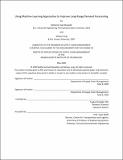Using Machine Learning Approaches to Improve Long-Range Demand Forecasting
Author(s)
Nowadly, Katherine; Jung, Sohyun
DownloadFull capstone (3.190Mb)
Metadata
Show full item recordAbstract
Achieving an accurate long-range forecast is a challenge many companies face due to the uncertainty in anticipating demand several years out. Since companies make strategic decisions based on these forecasts – such as long-term investments and supply and capacity planning – it is critical that the long-range forecast be as accurate as possible. For a large player in the pharmaceutical industry like our capstone project sponsor, an improvement in its forecasting process could have significant financial and organizational
benefits. While traditional statistical methods have been extensively used in demand forecasting, due to technological developments, machine learning approaches have been widely studied and increasingly applied in forecasting. Since machine learning has shown improvements in forecasting, especially in
short-term forecasting, could machine learning be applied to improve long-range forecasting? This study explores this question by testing several machine learning methodologies and approaches. First, we used support vector machine (SVM) to determine relevant features. Next we used two types of approaches, direct and recursive, to develop one-step and multi-step long-range forecasting models. We developed forecasts using four machine learning algorithms: random forest (RF), artificial neural network (ANN), linear regression (LR), and support vector machine (SVM). We found that RF, ANN, and LR produced relatively accurate results in the one-step models. However, when extending the forecasting horizon using a multi-step forecast,
the accuracy declines. By observing the results of the feature selection process and comparing the results among our forecasting models, we determined which features are critical when forecasting long-range demand for certain drugs. Additionally, we found that the machine learning model performance differed greatly based on data availability, forecasting horizon, and individual product. The biggest challenge in pursuing the application of machine learning approaches in long-range demand forecasting is data management. Given that using a machine learning approach in long-term forecasting has inconclusive performance, and creating a data management program would require a large up-front investment, a detailed cost-benefit analysis along with internal discussion is advised before pursuing further applications of machine learning in long-range demand forecasting.
Date issued
2020-08-06Keywords
machine learning, demand planning